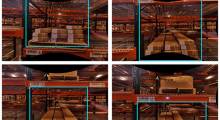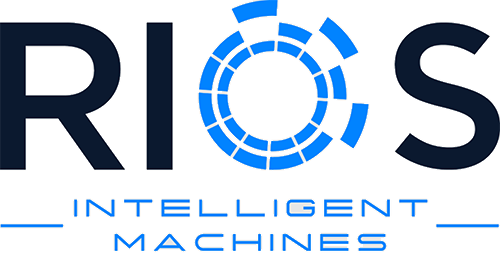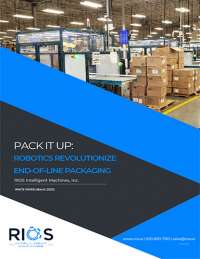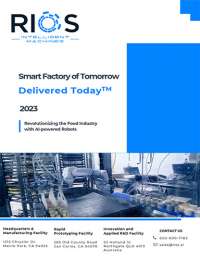There is an end-of-year tradition in tech companies to reflect on the technological trends that happened throughout the year and predict the future. Interestingly, Abraham Lincoln said that “The best way to predict the future is to create it” — which is essentially what we’ve done by founding RIOS two years ago.
We’ve articulated a thesis on how the future would unfold in the robotics space in the coming years, and how we should architect a world-changing company to truly make an impact in the world.
Two years ago, we made the following predictions below to investors. As with all predictions, there were way more disbelievers than believers.
We’ve seen our vision of the future come to life this year, and we strongly believe that in the next 1–2 years these predictions will become even more prevalent. Below are three RIOS team members who provided their thoughts on the trends in robotics and automation:
Dr. Bernard Casse — CEO
Fullstack robotics companies will prevail
We predicted that fullstack robotics companies will become the most dominant force. The robotics space is so fragmented that focusing on building components alone and relying on other slow-moving partners for integration and distribution, is not a sound strategy. After we exited from stealth mode, we’ve seen a few companies embrace the notion of acting as a systems integrator.
Interestingly, even some investors who didn’t believe in our original thesis ended up investing in new fullstack startups after being in denial for 2 years. There’s even the noteworthy case of an investor, whom we pitched during our inception, who recently quit his job at a VC firm to start a fullstack robotics company. We anticipate some existing companies to pivot to own more of the technology stack, and more startups are going to be funded to be fullstack companies.
Robots-as-a-Service (RaaS) business model will become more ubiquitous
We’ve long held the belief that the traditional business model of asking customers to pay upfront capital costs (CapEx) for automation will not cut it for new incumbents. We were early proponents of robots-as-a-service (RaaS) — we don’t charge for hardware or software; we deliver services to customers and only charge them operating costs (OpEx).
This year, with the toll of COVID-19 on global business, more companies than ever before are gravitating towards a pay-per-use model with no hefty upfront financial commitments. As companies’ revenues decline, this is going to become a permanent trend. We’ve seen startups switch from a software licensing business to a full-service business and adopting RaaS to be more responsive to customers’ needs. We expect more startups to follow the same path.
A Cambrian explosion in robotics is coming
Widespread automation is inevitable — it is only a matter of time. Labor shortages and more recently the pandemic have prompted more manufacturers and industries to accelerate automation. We’ve seen an uptick in customer demand and it’s not slowing down — it’s also very unlikely that a vaccine in sight will stifle automation. Robotics may have been technological curiosities a while back, but are now real options especially for many small and medium-size businesses.
There is also a lot of incentive to reshore to reduce the risk of globally distributed supply chains. In parallel, advancements in hardware/electronics, computing horsepower (GPUs + edge computing), AI, and cloud computing have made it possible to engineer more intelligent and capable machines. We’re going to see more startups in the robotics space emerge to leverage this massive technology infrastructure with the goal of grabbing a piece of a gargantuan market.
Mandy Dwight — VP of Business Development
It’s simple — the robotics and automation adoption that allowed companies to stay alive in 2020 will be what helps them thrive in 2021.
Automation remains a tool to survive and, above all, shrink costs
We’ve all heard expressions like, “if you are not thinking about automating now, you are already too late”. 2020 really put this into perspective with companies implementing robotics and automation at scrambling speeds in an effort to stay open and keep up with production.
With automation, many companies are realizing that not only are they able to produce and ship more product, but they are saving more money than expected on labor and support costs. These realized savings will lead to more investment in automation for 2021. Companies will be able to produce and ship goods at lower costs thanks to automation, a boost in a questionable economy.
Robots are not just for large corporations anymore
We have found large businesses continuing to invest in robotics, as expected, but the pandemic has encouraged small and medium-sized businesses to try robotics, as well. This trend will continue in 2021 primarily because traditional barriers to automation are being removed.
These barriers include large upfront equipment costs and the need for costly skilled labor within the facility to program and operate the equipment. Robots-as-a-Service (RaaS) models have been instrumental in allowing all businesses to adopt robotics quickly and inexpensively while providing ongoing support.
Flexible robotic solutions will support changes in consumer demand
One thing that hasn’t changed, and will not change in 2021, is consumer demand for a vast number of ever-changing and, often personalized, SKUs. Companies of all sizes will rethink their production processes with the adoption of flexible robotic solutions to support continued growth in these markets.
Rigid robotic solutions that are preprogrammed to complete one repetitive task no longer make sense when production needs to change as quickly as consumer tastes. Innovative companies who strive to maintain the loyalty of their consumers will invest in flexible solutions like robotic workcells that are rapidly reconfigurable for new tasks in the warehouse or to the changing needs of a supply chain’s workflow.
Dr. Chris Lalau-Keraly — Director of Engineering
One of the main trends of automation is centered around dealing with tasks that have higher degrees of entropy, i.e., less structure, and the robots being in charge of reducing this entropy, and executing tasks regardless of the initial state they are presented with.
We are presented with use cases like these from our clients every day, where a classical approach of how these robots are programmed is simply not viable. The new systems must have a much deeper understanding of their environment than they are used to and must know how to act upon that understanding.
The other trend is the speed at which systems are asked to be developed and deployed, and then repurposed in the field, requiring extreme agility in the design cycle by robotic companies. This is why I believe RIOS is extremely well poised to address this challenge.
By using a wide variety of sensing modalities, including our unique tactile sensing capability, and state of the art machine Learning and AI algorithms at the very core of our data processing pipelines, our systems can have a very fine and detailed understanding of their surroundings and their actions.
Our agile style of development for both hardware and software enable us to symbiotically develop both for maximum efficiency towards turning around systems for our clients, for whom time to deployment is one of the key metrics that can ensure they remain competitive.
Article topics
Email Sign Up



















